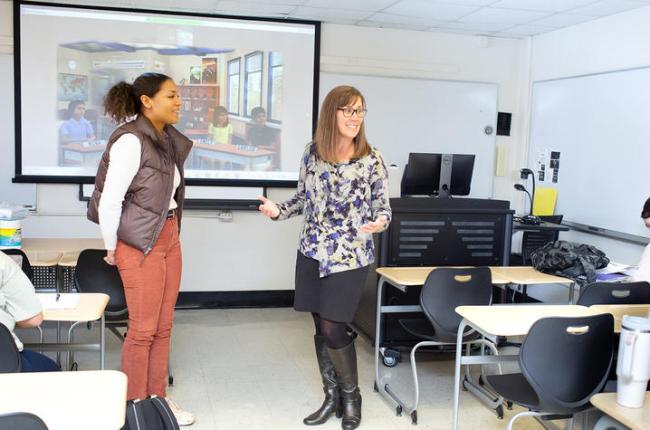Simulations help prepare Kentucky’s aspiring special education teachers
Before leading a classroom of their own, students preparing to become special education teachers are using mixed reality simulations to develop skills to be successful educators.
The UK SimLab at the University of Kentucky College of Education provides simulations for aspiring special education teachers across Kentucky. The simulations enable the college students to rehearse teaching in a controlled setting by interacting with avatars — brought to life behind the scenes by trained actors.
“The wonderful thing about using mixed reality simulations is that I can provide immediate feedback and coaching while the pre-service teacher is practicing the teacher behavior,” said Kera Ackerman, Ph.D., assistant professor of special education, UK College of Education. “We can pause the simulation to provide a correction, and then restart the simulation to practice the behavior again. We always say that it is the place to make a mistake because there is no impact on P-12 learners” she said.
Through a Kentucky Department of Education grant, the UK SimLab provides simulation services to all members of the Institution of Higher Education Special Education Consortium. This includes all colleges and universities in Kentucky that have special educator preparation programs, the Special Education Regional Technical Assistance Centers, and the Kentucky Department of Education Office of Special Education and Early Learning, Division of IDEA Implementation and Preschool.
“When special educators enter their classrooms well prepared for their role, the benefits are twofold. The teachers are more likely to remain in the field and their students experience better learning outcomes,” Ackerman said.
“We know that well-developed, practice-based opportunities are necessary to prepare our pre-service teachers to be ready for the work they will do, and by having the opportunity to practice their teacher behaviors through the simulations we know they can master the skills they need to be successful,” Ackerman said.
Teachers have to make multiple instructional decisions simultaneously based on factors that can change at any given moment — from the environmental arrangement of the room to whether or not the learner had breakfast that morning.
Aspiring educators practice several high leverage practices in the simulations, such as explicit instruction, engagement strategies and providing feedback. Other practice-based opportunities they use include responding to student behavior and collaborating with parents — specifically engaging a parent in an Individualized Education Program meeting.
“I have had multiple students tell me a particular student behavior or parent interaction happened in their clinical field placement classroom and they knew how to handle it because of practicing in the simulation,” Ackerman said.
Mixed virtual reality helps add to the diversity of experiences pre-service teachers encounter on their path to becoming a teacher. The simulations include various age levels, from preschool to high school, and multiple content areas. The response settings of the avatars can be adjusted to exhibit varying degrees of student behaviors.
“For example, we can select middle school level language arts content, with high behavior. This allows our pre-service teacher to practice delivering content and managing behavior simultaneously, but in a safe space, with the support of the instructor and their classmates,” Ackerman said.
The simulations take place both in a college classroom and as homework assignments completed outside of class. In class, each pre-service teacher has an opportunity to participate in the simulation while the instructor and other pre-service teachers observe and provide feedback throughout the simulation and immediately after. When completing the simulation at home, students may choose to record the session for feedback from their instructor or to re-watch and reflect on themselves. Sometimes the host avatar may provide basic feedback at the conclusion of the setting.
“The beauty of the simulations is that they are consistent across opportunities,” Ackerman said. “All pre-service teachers at institutions across Kentucky can practice the same skill in the same way in a safe environment. By allowing them time to master the skills and reflect on their practice before additional variables are added, pre-service teachers are more confident and better prepared for the classroom.”

